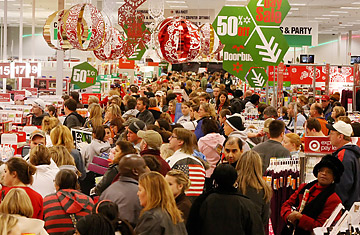
A crowd of shoppers seeking bargains at Target in Cool Springs, Tennessee, bought electronics, apparel and toys on Friday, November 27, 2009
Preliminary data indicates Black Friday sales got off to a roaring start this year, with consumers shopping earlier and online sales increasing significantly over last year.
Retailers across the board reported strong crowds early Friday, with high-definition televisions, laptops, winter coats and the popular toy Zhu-Zhu pets among the hottest items. "There were bargain-hungry shoppers out there, and retailers really did pull out all the stops for people," says Kathy Grannis, a spokesperson for the National Retail Federation, noting that many of the day's hot item carried the steepest discounts.
Some of the sales bump is likely resulting from an expansion of the Black Friday sales hours. Many brick-and-mortar retailers opened their doors as early as midnight — rather than the traditional 6 a.m. shotgun start, and some offered their door-crasher deals online even earlier — on Thanksgiving day. "Many retailers took their Black Friday sale items and put them online on Thursday starting just after midnight on Wednesday," says Fiona Dias, executive vice president of strategy and marketing for GSI Commerce, a company that runs about 80 e-commerce websites for retailers and fashion designers. "This was a major shift this year."
One sign of this trend: PayPal reported a 25% increase in the dollar volume of sales on Thanksgiving Day from the same day a year ago, according to Amanda Pires, senior director at PayPal. The online pay site is used by consumers to make purchases at online retailers and at its sister site, eBay.
Still, Friday had its own energy — early data indicates traffic for the day to both brick-and-mortar retailers and online retail sites was up.
"It's like night and day," says Matthew Katz, managing director at consultancy AlixPartners' retail practice, whose team traveled to about 30 malls, big box retailers and strip-mall centers to monitor activity today in different parts of the country. "I purposely went to the same mall in Short Hills, N.J. at 9 a.m. as I went to last year, he says. "Last year [on Black Friday] I parked in the front row, and this year it took me about 20 minutes to get a spot."
Katz says the busiest stores, from a traffic perspective, were Apple, GameStop, Toys R Us and Best Buy, although the retailers with the most people carrying shopping bags were department stores.
Online retailers were busy too. GSI's flock of web retailers averaged 520 orders in their peak minute of sales on Black Friday, up from 430 orders during the peak minute a year ago. "It was about 20% higher orders per minute than it was last year,' says Dias. However, she speculates it's possible orders will drop off on Saturday and Sunday if shoppers were only seeking time-limited door-crash specials.
Cyber Monday will be another big day for online retailers, though here, too, the calendar boundaries have been blurred. Online retailer Amazon, for example, is offering a constantly updated list of special discounts and calling it "Black Friday Deals Week."
The biggest insight to come from Black Friday sales data will be changes in shopper behavior. People may be getting more time to find deals this year, but there are fewer big deals to find — the 75% to 80% markdowns seen during last year's holiday season are now rare. Retailers purchased up to 20% less inventory this year in anticipation of slower sales, so they're not under the gun to slash prices to clear inventory — at least not yet.
The really big markdowns were on specific items, not across the store as they were last year, says Katz. "They were price-point driven, not percent-off driven," he says. "You saw a lot of gifts under $50 or gifts under $100 — you didn't see 50% off."
"From a traffic perspective, there were more people in the malls than in years past," he says. However, it's not yet known if traffic translated into big sales, as this data will not be available until later this weekend.
Even if the final tally indicates sales surpassed last year's numbers, it's not necessarily clear sailing for retailers through the holiday season. The average shopper spent $372 over the Black Friday weekend last year, which was up from $347 the previous year, says Grannis. Yet, holiday sales, which tracks total sales through November and December, fell 3.4% — the first decline since the NRF started tracking sales in the mid-1990s, she says.
Says retail consultant Katz: "There's a lot of positive momentum, but we're not out of the woods."
